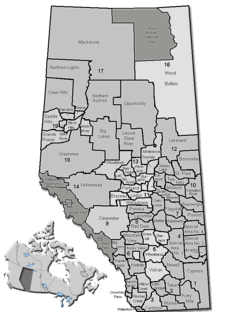Municipal District of Opportunity No. 17
| Municipal District of Opportunity No. 17 | |
|---|---|
| Municipal district | |
 Location of Opportunity No. 17 in Alberta | |
| Coordinates: 55°56′59″N 113°49′20″W / 55.94972°N 113.82222°WCoordinates: 55°56′59″N 113°49′20″W / 55.94972°N 113.82222°W | |
| Country |
|
| Province |
|
| Region | Northern Alberta |
| Census division | No. 17 |
| Established | 1995 |
| Incorporated | 1995 |
| Government[1] | |
| • Reeve | Paul Sinclair |
| • Governing body | M.D. of Opportunity Council |
| • Office location | Wabasca |
| Area (2011)[2] | |
| • Total | 29,140.78 km2 (11,251.32 sq mi) |
| Population (2011)[2] | |
| • Total | 3,074 |
| • Density | 0.1/km2 (0.3/sq mi) |
| • Dwellings | 1,460 |
| Time zone | MST (UTC-7) |
| Website |
mdopportunity |
The Municipal District of Opportunity No. 17 is a municipal district occupying a large remote area in central northern Alberta, Canada. Located in Census Division 17 north of the Town of Athabasca, its municipal office is located in the Hamlet of Wabasca.
History
The Municipal District of Opportunity No. 17 was established as a municipal district on August 1, 1995 from the former Improvement District No. 17 East (North).
Economy
The economy of the Municipal District of Opportunity No. 17 includes oil and gas production, forestry, as well as diamond exploration. The municipality also offers the lowest residential tax rate in the Province of Alberta as part of its efforts to attract and retain residents.[3]
Demographics
The Municipal District of Opportunity No. 17's 2013 municipal census counted a population of 3,061,[4] a −6.1% change from its 2007 municipal census population of 3,259.[5]
In the 2011 Census, the Municipal District of Opportunity No. 17 had a population of 3,074 living in 974 of its 1,430 total dwellings, a 8% change from its 2006 population of 2,847. With a land area of 29,140.78 km2 (11,251.32 sq mi), it had a population density of 0.1/km2 (0.3/sq mi) in 2011.[2]
In 2006, the Municipal District of Opportunity No. 17 had a population of 2,847 living in 1,460 dwellings, a -6.3% increase from 2001. The municipal district has a land area of 29,140.78 km2 (11,251.32 sq mi) and a population density of 0.1/km2 (0.26/sq mi).[6] The majority of the municipal district's 2006 population, 2,390 people or 84%, identified themselves as Aboriginal.[6]
In 2001, the municipal district had a population of 3,436 in 1,488 dwellings, a 12.3% increase from 1996. On a surface of 29,179.91 km² it had a density of 0.1 inhabitants/km².[7]
Communities and localities
|
The following urban municipalities are surrounded by the Municipal District of Opportunity No. 17:[8]
The following hamlets are located within the Municipal District of Opportunity No. 17:[8]
|
The following localities are located within the Municipal District of Opportunity No. 17:[9]
|
See also
References
- ↑ Alberta Municipal Affairs: Municipal Officials Search
- 1 2 3 "Population and dwelling counts, for Canada, provinces and territories, and census subdivisions (municipalities), 2011 and 2006 censuses (Alberta)". Statistics Canada. 2012-02-08. Retrieved 2012-02-08.
- ↑ Stepher Scriver, AAMDC: The 100-Year Story of Alberta's Rural Cornerstone (2008: AADMC: Edmonton), at p. 65
- ↑ "2013 Municipal Affairs Population List" (PDF) (PDF). Alberta Municipal Affairs. November 20, 2013. ISBN 978-1-4601-1418-6. Retrieved December 5, 2013.
- ↑ "2011 Municipal Affairs Population List" (PDF) (PDF). Alberta Municipal Affairs. October 5, 2011. ISBN 978-0-7785-9738-4. Retrieved December 5, 2013.
- 1 2 "2006 Community Profiles: Opportunity No. 17, Alberta (Municipal district)". Statistics Canada. 2010-12-06. Retrieved 2012-06-14.
- ↑ M.D. of Opportunity community profile - Statistics Canada. 2002. 2001 Community Profiles. Released June 27, 2002. Last modified: 2005-11-30. Statistics Canada Catalogue no. 93F0053XIE
- 1 2 "Specialized and Rural Municipalities and Their Communities" (PDF). Alberta Municipal Affairs. 2012-03-01. Retrieved 2012-08-11.
- ↑ "Standard Geographical Classification (SGC) 2006, Economic Regions: 4817031 - Opportunity No. 17, geographical codes and localities, 2006". Statistics Canada. 2010-03-05. Retrieved 2012-08-11.
External links
 |
Mackenzie County | Regional Municipality of Wood Buffalo |  | |
| Northern Sunrise County | |
Lac La Biche County | ||
| ||||
| | ||||
| Municipal District of Lesser Slave River No. 124 | Athabasca County |